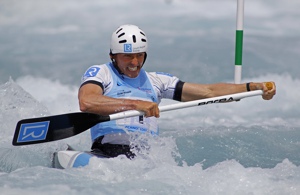Canoe Slalom Rules

Canoe Slalom – also known as 'Whitewater Slalom' – is a competitive water sport where athletes navigate boats through a series of gates on white water river rapids. Participants power their vehicles using paddles, and are forced to deal with turbulent conditions whilst attempting to complete the course in the fastest time possible.
Canoe Slalom involves differently designed boats to Canoe Sprint, with smaller dimensions that help to assist athletes navigate their way through the rapids with a greater degree of manoeuvrability and control. The two types of boats used in a Canoe Slalom race are canoe boats and kayak boats.
Canoe Slalom first appeared as a competitive sport back in the 1940’s, although unlike Canoe Sprint, it did not become a permanent fixture at the Olympics until 1992. France and Slovakia have experienced great success in Olympic Slalom events, whilst the Czech Republic, Spain and Germany have also picked up gold medals.
Object of the Game
The object of Canoe Slalom is to complete the course in the fastest possible time. There are four competitive events contested in Olympic Canoe Slalom. These include:
- Men's C-1: One male in a single canoe boat
- Men's C-2: Two males in a double canoe boat (set to be dropped for future Olympic events)
- Men's K-1: One male in a single kayak boat
- Women's K-1: One female in a single kayak boat
- Women’s C-1: One female in a single canoe boat (this is due to be added to the games program for the 2020 Olympics).
Players & Equipment
Most Canoe Slalom races are single events. There was a Men’s Doubles tournament in the past, but officials have recently decided to drop this event and introduce a new Women’s Singles competition instead. Races are contested in canoe boats or kayak boats, with participants using particular paddles to navigate their way through the course.
Canoe Boats
In canoe boats, athletes use single-bladed paddles. The types of canoes used in Canoe Slalom are known as “closed cockpit canoes”, with competitors taking a kneeling stance when driving.
Kayak Boats
In kayak boats, athletes use a paddle that has a blade at either end. Kayaks are available in a wide variety of different designs, are used in several types of water sports in addition to Canoe Slalom. Competitors sit inside a cockpit when driving kayak boats.
Courses
Every course in Canoe Slalom is fitted with 18 to 25 different gates, which have to be negotiated in a particular way. Green gates are downstream, whereas red gates are upstream. Canoe Slalom courses at the Olympic games are man-made concrete channels, and most teams train on their own artificial courses in the lead up to the games.
Scoring
Canoe Slalom involves completing the course in the fastest possible time, and whilst there is no points system as such, players can be given time penalties for failing to adhere to rules and regulations on the course. The fastest Canoe Slalom players often complete courses in less than two minutes, but this can vary depending on the complexity of the course and difficulty of the conditions.
Winning
In order to win a Canoe Slalom competition outright, players must progress through the qualification rounds first. These are known as “heats”, and are completed twice by all athletes. The fastest boats then proceed to the semi-finals, where every participant has one opportunity to tackle the course. The fastest boats in the semi-finals then progress to the final, where the top ranked boats are awarded the gold, silver and bronze medals.
Rules of Canoe Slalom
Tiebreaks
Athletes take two runs at the course during the heats. If any athletes are tied after both runs, they will all progress to the semi-finals. If any athletes are tied in the semi-finals, again, they will all move on to the final. If there are ties during the final, the gold medal will be shared by all the boats that tied for first place.
Penalties
Athletes can incur time penalties by failing to adhere to rules and regulations whilst competing on the course, and a certain number of seconds will be added to their finishing time as punishment. Penalties can be given for:
- Touching a gate pole with a paddle or the boat itself (2 second penalty)
- Taking a gate incorrectly – which includes missing the gate, displacing it by more than 45 degrees, or going through the gate upside-down (50 second penalty)
Boat Dimensions
All canoe and kayak boats are required to meet certain criteria in terms of their size, shape, weight and length. The measurement rules are as follows:
- K1 Boats: 3.50m minimum length, 0.6m minimum width, 8kg minimum weight
- C1 Boats: 3.50m minimum length, 0.6m minimum width, 8kg minimum weight
- C2 Boats: 4.10m minimum length, 0.75 minimum width, 13kg minimum weight